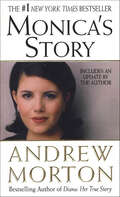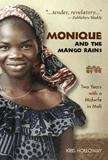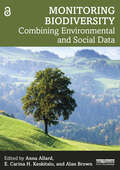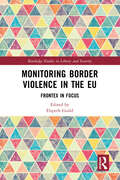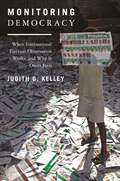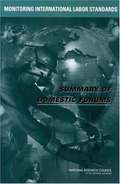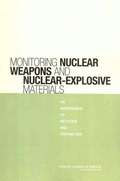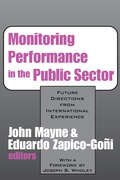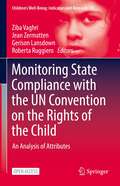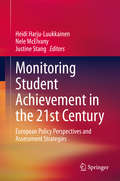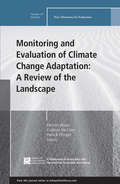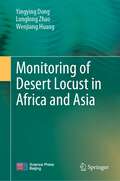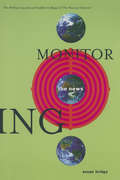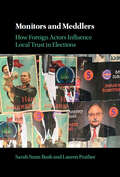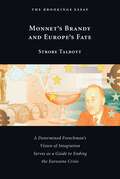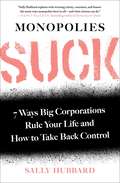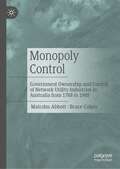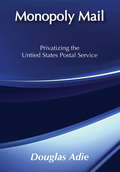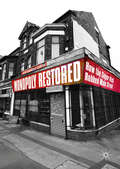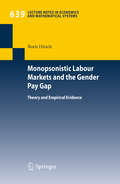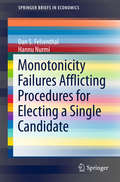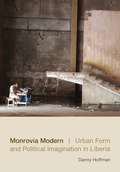- Table View
- List View
Monica's Story
by Andrew MortonGo beyond the headlines of the Clinton-Lewinsky scandal and revisit the story of Monica Lewinsky in this authorized biography from Andrew Morton, the basis for the FX miniseries Impeachment.Monica Lewinsky. You know her name, you know her face, and you think you know her story: the pretty young intern who began an illicit affair with the President of the United States-- a liaison that ignited an unprecedented political scandal and found Bill Clinton as the second U.S. president to ever be impeached. But there is much more to the Monica Lewinsky story than just that. Andrew Morton, author of the #1 New York Times bestseller, Diana: Her True Story, takes you behind the headlines and the sound bites to discover the real Monica Lewinsky, a woman as interesting, intelligent, and misunderstood as they come.Read Monica's Story and you'll discover:* How a difficult childhood shaped Monica's tumultuous adult romances* Her relationship with Bill Clinton: how she saw a side to him few know-- and why she sometimes still missed her "Handsome"* The betrayal by Linda Tripp-- and how Monica's trusting nature snared her in Tripp's treacherous web* The horror of Kenneth Starr's exhaustive and intrusive inquiry-- how it affected her and her family, and how it still haunts her* What Monica's hopes were, in the wake of the scandal, from career plans, to marrying, and family life.* And much, much moreWith sixteen pages of photographs.
Monique and the Mango Rains: Two Years With A Midwife in Mali
by Kris Holloway John BidwellMonique and the Mango Rains is the compelling story of a rare friendship between a young Peace Corps volunteer and a midwife who became a legend. Monique Dembele saved lives and dispensed hope in a place where childbirth is a life-and-death matter. This book tells of her unquenchable passion to better the lives of women and children in the face of poverty, unhappy marriages, and endless backbreaking work. Monique's buoyant humor and willingness to defy tradition were uniquely hers. In the course of this deeply personal narrative, as readers immerse themselves in the rhythms of West African village life, they come to know Monique as friend, mother, and inspired woman.
Monitoring Biodiversity: Combining Environmental and Social Data
by Alan Brown Anna Allard Keskitalo, E. Carina H.This book is an exciting reappraisal of the role and practice of biodiversity monitoring, showing how new technologies and software applications are rapidly maturing and can both complement and maintain continuity with the best practice in traditional field skills. Environmental monitoring is a key component in a large number of national programmes and constitutes an important aspect of understanding environmental change and supporting policy development. Taking an interdisciplinary approach, Monitoring Biodiversity begins by discussing monitoring as an established field and examines the various budgetary and technological challenges. It examines different methodologies, the variation between countries, and the design features relevant to understanding monitoring systems created for new policy goals or different funding situations. The huge variety of methods revealed across 18 chapters, which vary from statistical designs to remote sensing, interviews, surveys, and new ways of stacking and combining data and thematic information for visualization and modelling, underlines just how mature and multifaceted the modern practice of monitoring can be. It concludes with several problem-based chapters that discuss the design and implementation of environmental monitoring in specific scenarios such as urban and aquatic areas. All chapters include key messages, study questions, and further reading. With a focus on Europe but with international relevance, Monitoring Biodiversity will be an essential resource for students at all levels of environmental monitoring, assessment, and management.
Monitoring Border Violence in the EU: Frontex in Focus (Routledge Studies in Liberty and Security)
by Elspeth GuildThis book examines EU external border violence and the role of Frontex, and how it can be made legally and politically accountable for these incidents. The volume sets out what the international standards are for monitoring border violence and how monitors’ independence must be guaranteed and where these standards come from. The book provides realistic options to resolve the crisis by focusing on how effective and independent border monitoring can ensure better human rights compliance at EU external borders. At the centre of the book is the question: how can we achieve effective monitoring of border police, including Frontex, by competent and independent state authorities which have as a mission human rights implementation? The goal of the book is to examine how states can prevent and investigate allegations of such violence and diminish the apparent impunity of those border police who engage in it. This book will be of interest to students of EU policy, law, migration and refugee studies and International Relations.
Monitoring Democracy: When International Election Observation Works, and Why It Often Fails
by Judith G. KelleyIn recent decades, governments and NGOs--in an effort to promote democracy, freedom, fairness, and stability throughout the world--have organized teams of observers to monitor elections in a variety of countries. But when more organizations join the practice without uniform standards, are assessments reliable? When politicians nonetheless cheat and monitors must return to countries even after two decades of engagement, what is accomplished? Monitoring Democracy argues that the practice of international election monitoring is broken, but still worth fixing. By analyzing the evolving interaction between domestic and international politics, Judith Kelley refutes prevailing arguments that international efforts cannot curb government behavior and that democratization is entirely a domestic process. Yet, she also shows that democracy promotion efforts are deficient and that outside actors often have no power and sometimes even do harm. Analyzing original data on over 600 monitoring missions and 1,300 elections, Kelley grounds her investigation in solid historical context as well as studies of long-term developments over several elections in fifteen countries. She pinpoints the weaknesses of international election monitoring and looks at how practitioners and policymakers might help to improve them.
Monitoring International Labor Standards: International Perspectives
by Crispin Rigby National Research Council (U.S) StaffA report on Monitoring International Labor Standards
Monitoring International Labor Standards: Quality Of Information
by Margaret Hilton National Research Council (U.S.), Policy and Global Affairs Staff National Research Council (U.S.), Division of Behavioral and Social Sciences and Education Staff National Academies (U.S.), Committee on Monitoring International Labor Standards StaffThe National Academies Press (NAP)--publisher for the National Academies--publishes more than 200 books a year offering the most authoritative views, definitive information, and groundbreaking recommendations on a wide range of topics in science, engineering, and health. Our books are unique in that they are authored by the nation's leading experts in every scientific field.
Monitoring International Labor Standards: Summary of Domestic Forums
by Roger G. McelrathSince 1943, Recommended Dietary Allowances (RDAs) has been recognized as the most authoritative source of information on nutrient levels for healthy people. Since publication of the 10th edition in 1989, there has been rising awareness of the impact of nutrition on chronic disease. In light of new research findings and a growing public focus on nutrition and health, the expert panel responsible for formulating RDAs reviewed and revised its approach -- the result: Dietary Reference Intakes. This new series of references greatly extends the scope and application of previous nutrient guidelines. The first volume includes calcium, magnesium, phosphorus, vitamin D, and fluoride. For each nutrient the committee presents what is known about how the nutrient functions in the human body, which factors (caffeine or exercise, for example) may affect how it works, and how the nutrient may be related to chronic disease. Based on analysis of nutrient metabolism in humans and data on intakes in the U. S. population, the committee recommends intakes for each age -- from the first days of life through childhood, sexual maturity, midlife, and the later years. Recommendations for pregnancy and lactation also are made, and the book identifies when intake of a nutrient may be too much. Dietary Reference Intakes provides three sets of measures for each nutrient in the volume: -- Estimated Average Requirements (EARs), estimated for age and gender categories. -- Recommend
Monitoring Nuclear Weapons And Nuclear-explosive Materials
by National Academy of Sciences of the National AcademiesIn this study, CISAC tackles the technical dimensions of a longstanding controversy: To what extent could existing and plausibly attainable measures for transparency and monitoring make possible the verification of all nuclear weapons—strategic and nonstrategic, deployed and nondeployed—plus the nuclear-explosive components and materials that are their essential ingredients? The committee’s assessment of the technical and organizational possibilities suggests a more optimistic conclusion than most of those concerned with these issues might have expected.
Monitoring Performance in the Public Sector: Future Directions from International Experience (Comparative Policy Evaluation Ser.)
by John Winston MayneA host of promising public sector reform efforts are underway throughout the world. In governments challenged by budget deficits and declining public trust, these reform efforts seek to improve policy decisions and public management. Along the way, program efficiency and effectiveness help rebuild public confidence in government. Whether through regular measurement of program inputs, activities, and outcomes, or through episodic one-shot studies, performance monitoring plays a central role in the most important current reform efforts. Monitoring Performance in the Public Sector, now available in paperback, is based on experiences derived from comparative analysis in different countries. It explains why there is interest in perfor!mance monitoring in a given setting, why it has failed or created uncertainties, and identifies criteria for improving its design and use.One of the challenges this book offers is the need to consider dimensions of performance beyond the traditional ones of economy, efficiency, and effectiveness. With an increasingly diverse, interdependent, and uncertain public sector environment, for some stakeholders meeting objectives fixed some time ago may not be as important as the capacity to adapt to current and future change. In this vein, the contributors address a number of themes: the criti!cal importance of organizational support for performance monitoring and making it consistent with the organizational culture, the need for active and effective leadership in defining criteria and implementing practical performance monitoring, the value of linking ongoing measurement with more than the traditional, strictly quantitative aspects of public sector performance.As we gain experience with performance monitoring and its uses, such systems should become more cost effective over time. This book will be of deep interest to public managers, government officials, economists, and organization theorists, and useful in courses on p
Monitoring State Compliance with the UN Convention on the Rights of the Child: An Analysis of Attributes (Children’s Well-Being: Indicators and Research #25)
by Ziba Vaghri Jean Zermatten Gerison Lansdown Roberta RuggieroThis open access book presents a discussion on human rights-based attributes for each article pertinent to the substantive rights of children, as defined in the United Nations Convention on the Rights of the Child (UNCRC). It provides the reader with a unique and clear overview of the scope and core content of the articles, together with an analysis of the latest jurisprudence of the UN Committee on the Rights of the Child. For each article of the UNCRC, the authors explore the nature and scope of corresponding State obligations, and identify the main features that need to be taken into consideration when assessing a State’s progressive implementation of the UNCRC. This analysis considers which aspects of a given right are most important to track, in order to monitor States' implementation of any given right, and whether there is any resultant change in the lives of children. This approach transforms the narrative of legal international standards concerning a given right into a set of characteristics that ensure no aspect of said right is overlooked. The book develops a clear and comprehensive understanding of the UNCRC that can be used as an introduction to the rights and principles it contains, and to identify directions for future policy and strategy development in compliance with the UNCRC. As such, it offers an invaluable reference guide for researchers and students in the field of childhood and children’s rights studies, as well as a wide range of professionals and organisations concerned with the subject.
Monitoring Student Achievement in the 21st Century: European Policy Perspectives and Assessment Strategies
by Heidi Harju-Luukkainen Nele McElvany Justine StangThis book draws together leading student assessment academics from across Europe exploring student monitoring policies and practices in a range of countries across 22 chapters. The chapters in the first part offer a broad overview on student assessment covering history and current status, aims and approaches as well as methodological challenges of international student assessment. The second part presents country specific chapters provide an in depth look examining country specific policy and practices and findings of national and/or international assessments. Findings are critically discussed and recommendations are made for further development of each country's assessment context. The book shows similarities and differences within the educational assessment landscape as well as complexity and similarities in assessment policy documents and strategies, Given the globalized world we live in today, this book fills a need in the higher educational context and is intended for for policy makers in different countries as well.
Monitoring and Evaluation of Climate Change Adaptation: New Directions for Evaluation, Number 147 (J-B PE Single Issue (Program) Evaluation)
by Patrick Pringle Dennis Bours Colleen McGinnMonitoring and evaluation (M&E) of climate change adaptation (CCA) poses an assortment of thorny methodological challenges. Individually, none are unique to CCA, but together they represent a very distinctive conundrum facing practitioners and policy makers. Adding to this complexity further, climate change may be global in nature but its impacts, and how we respond to them through adaptation efforts, cut across scales, sectors, and levels of intervention. As investments in climate adaptation increase, organizations are seeking to measure, assess and understand an array of adaptation initiatives, and derive learnings to inform policy and praxis. This issue presents findings from many of the most important contemporary CCA program evaluation research initiatives. The chapters represent the most coherent and current collection of CCA M&E research in this emerging and important field, written by many of its leading experts. Filled with examples and insights in formulating coherent responses to methodological challenges, it will be of interest to M&E scholars and practitioners globally.This is the 147th issue in the New Directions for Evaluation series from Jossey-Bass. It is an official publication of the American Evaluation Association.
Monitoring of Desert Locust in Africa and Asia
by Yingying Dong Longlong Zhao Wenjiang HuangThis book deals with the topic on remote sensing monitoring of desert locust in Africa and Asia. Remote sensing monitoring of the occurrence and damage of desert locust is conducted by integrating cutting-edge technologies and methods in cross-disciplinary fields in remote sensing science, geographic information science, agronomy, plant protection, agricultural meteorology, mathematics, and computer science. The main contents include spatio-temporal data analysis and processing, desert locust breeding areas monitoring, pest migration path analysis and damage monitoring. Moreover, a desert locust remote sensing monitoring system is constructed and applied in the region of Africa and Asia countries. This book not only provides technical reference for remote sensing monitoring and application of desert locust but also serves as a research reference for scholars and graduate students engaged in agricultural remote sensing, agricultural information technology, plant protection and other related field. It will help to improve remote sensing monitoring and application of desert locust.
Monitoring the News: The Brilliant Launch and Sudden Collapse of the Monitor Channel
by Susan BridgeIn her colorful insider's account, Susan Bridge analyzes the bitter struggle that ensued when a sophisticated entrepreneurial leadership tried to diversify and reposition "The Christian Science Monitor" beyond the failing newspaper into radio, the Internet, multimedia publishing, and -- the highest-ticket item of all -- The Monitor Channel, a CNN-style, 24-hour news and public affairs channel. Using the Monitor's story as a focus, Susan Bridge raises fundamental questions about how and whether the public's interest can be served in an age of spiraling costs, competition between print and electronic media, changing public tastes, and undeclared media wars.
Monitors and Meddlers: How Foreign Actors Influence Local Trust in Elections
by Sarah Sunn Bush Lauren PratherForeign influences on elections are widespread. Although foreign interventions around elections differ markedly-in terms of when and why they occur, and whether they are even legal-they all have enormous potential to influence citizens in the countries where elections are held. Bush and Prather explain how and why outside interventions influence local trust in elections, a critical factor for democracy and stability. Whether foreign actors enhance or diminish electoral trust depends on who is intervening, what political party citizens support, and where the election takes place. The book draws on diverse evidence, including new surveys conducted around elections with varying levels of democracy in Georgia, Tunisia, and the United States. Its insights about public opinion shed light on why leaders sometimes invite foreign influences on elections and why the candidates that win elections do not do more to respond to credible evidence of foreign meddling.
Monkey Trials and Gorilla Sermons: Evolution and Christianity from Darwin to Intelligent Design (New Histories of Science, Technology, and Medicine)
by Peter J. BowlerFrom the beginning, Darwin’s dangerous idea has been a snake in the garden, denounced from pulpits then and now as incompatible with the central tenets of Christian faith. Recovered here is the less well-known but equally long history of thoughtful engagement and compromise on the part of liberal theologians. Peter J. Bowler doesn’t minimize the hostility of many of the faithful toward evolution, but he reveals the existence of a long tradition within the churches that sought to reconcile Christian beliefs with evolution by finding reflections of the divine in scientific explanations for the origin of life. By tracing the historical forerunners of these rival Christian responses, Bowler provides a valuable alternative to accounts that stress only the escalating confrontation. Our polarized society, Bowler says, has all too often projected its rivalries onto the past, concealing the efforts by both scientists and theologians to find common ground. Our perception of past confrontations has been shaped by an oversimplified model of a “war” between science and religion. By uncovering the complexity of the debates sparked by Darwin’s theory, we might discover ways to depolarize our own debates about where we came from and why we are here.
Monnet's Brandy and Europe's Fate
by Strobe TalbottThe past five years have been turbulent for the eurozone. Yet leaders such as Angela Merkel and Fran ois Hollande are determined to keep The European Project intact, and even among one-time critics there is a broad consensus that the eurozone will have to hang together. Strobe Talbott introduces the extraordinary life and vision of Jean Monnet--the man credited as the architect of European unity. Monnet died in 1979, long before the euro went into circulation, and his relevance today is all the more striking in light of his idiosyncratic career. He was born in 1888 to a long line of brandy artisans. He had no formal training as an economist, yet he is ranked alongside Keynes. He was never elected to public office, and his fellow countrymen sometimes mocked him as "the great American." Ironically, some believed that Monnet's arguments were particularly effective with FDR, and later speculated that they might even have helped shorten World War II by a year.In this essay, Talbott demonstrates how Monnet's vision of integration may serve as a guide to ending the current eurozone crisis. With minds in key capitals now focused on cobbling together institutional measures of the sort that Monnet believed necessary for monetary union, his vision of a united Europe may well survive and, over time, succeed.
Monopolies Suck: 7 Ways Big Corporations Rule Your Life and How to Take Back Control
by Sally HubbardAn urgent and witty manifesto, Monopolies Suck shows how monopoly power is harming everyday Americans and practical ways we can all fight back.Something&’s not right. No matter how hard you work, life seems to only get harder. When your expenses keep going up but your income stays flat, when you&’re price-gouged buying medicine for your child&’s life-threatening allergy, when you live in a hyped-up state of fear and anxiety, monopoly power is playing a key role. In Monopolies Suck, antitrust expert and director at the Open Markets Institute, Sally Hubbard, shows us the seven ways big corporations rule our lives—and what must be done to stop them. Throughout history, monopolists who controlled entire industries like railroads and oil were aptly called &“robber barons&” because they extracted wealth from everyone else—and today&’s monopolies are no different. By charging high prices, skirting taxes, and reducing our pay and economic opportunities, they are not only stealing our money, but also robbing us of innovation and choice, as market dominance prevents new companies from challenging them. They&’re robbing us of the ability to take care of our sick, a healthy food supply, and a habitable planet by using business practices that deplete rather than generate. They&’re a threat to our private lives, fair elections, a robust press, and ultimately, the American Dream that so many of us are striving for. In this slim, accessible guide, Sally Hubbard gives us an easy-to-understand overview of the history of monopolies and antitrust law, and urges us to use our voices, votes, and wallets to protest monopoly power. Emboldened by the previous century when we successfully broke up monopoly power in the US, we have the tools to dismantle corporate power again today—before their lobbying threatens to undermine our economy and democracy for generations to come.
Monopoly Control: Government Ownership and Control of Network Utility Industries in Australia from 1788 to 1988
by Bruce Cohen Malcolm AbbottThis book traces the historical development of the network utilities sector in Australia (communications, rail, gas, electricity, water supply, and sewerage services). It looks across industries, time periods and the state and federal jurisdictions, to identify what motivated the various governments to establish these enterprises and what issues arose. The book is therefore informed by the relationship between politics and society on the one hand and economic history on the other; as well as the efforts of governments in Australia to promote economic growth and the wealth of Australians. The main focus of the book is to identify and analyse the following two main questions: (i) What were the main drivers and motivations for governments establishing government-owned business in the network utilities sector? (ii) To what degree were these government-owned businesses successful at achieving the aims of these governments? In doing so the inherent characteristics of these industries are identified, in terms of their need for rights of way, network effects, the monopoly characteristics, and the potential for stimulating growth.
Monopoly Mail: Privatizing the United States Postal Service (The\economics Of The Service Sector In Canada Ser.)
by Douglas AdieFirst class postage rates have risen from six cents in 1971 to 25 cents in 1988. This rapid increase might be justifiable if service had improved commen-surately, but in fact postal service has steadily deteriorated. The Postal Service concedes that it takes ten percent longer to deliver a first class letter than it did in the 1960s, and one recent postmaster general admits that delivery may have been more reliable in the 1920s. In this volume, Adie reviews the failures of the U.S. Postal Service - an inability to innovate, soaring labor costs, huge deficits, chronic inefficiency, and declining service standards. He blames most of these problems on the postal service's monopoly status. Competition produces efficiency and innovation; monopoly breeds inefficiency, high costs and stagnation. He also examines the experiences of other countries and other industries that may be valuable in prescribing reform for the postal service. The breakup of AT&T provides lessons that may be applied to postal reform. The long-run effects of deregulation on the airline industry are also examined. Since the postal service has serious union problems, Adie looks at the air traffic controllers' strike and other evidence on pay and labor relations in government unions. Finally, Adie examines the experiences of Canada and Great Britain with privatization of government companies. He then offers a comprehensive - and controversial - reform plan for the U.S. Postal Service, with no further monopoly privileges or taxpayer subsidies. He argues that private companies should be free to compete with the Postal Service, and it, in turn, should be free to compete in all phases of the communications business. Without privatization and deregulation, the Postal Service is doomed to continuing inefficiency, rising costs, worsening labor relations, and an increasing loss of customers to more innovative and efficient service providers. Competition would give the Postal Service a chance to enter the 21st ce
Monopoly Restored: How the Super-Rich Robbed Main Street
by Jack Lawrence LuzkowThis book is a work of contemporary economic history focusing primarily on the US and the UK. It shows that, historically, much of the wealth of the ultra-wealthy has been based on inheritance, tax evasion, political influence, or wage theft. Today, much of the wealth of the rentier class—the super-rich—is based on income from ownership or control of scarce assets, or assets artificially made scarce. As a result, the super-rich reap much of their wealth from patents, monopolies, and subsidies. Their banks retain the right to speculate on risky derivatives, and their credit-card companies are not limited by usury laws that reduce interest rates. The super-rich have lowered (or escaped) inheritance taxes, shifted much of their income to lower taxed capital gains, practiced wage theft, fought minimum wage laws, outsourced jobs, and resorted to temps and contract labor to avoid unions and decent wages. They use tax havens where trillions of dollars remain untaxed, transfer profits of their intellectual and financial property to subsidiaries in low-tax regimes, and defend for-profit health insurance that is unaffordable and inequitable for millions. This book states in qualitative and quantitative terms how expensive the super-rich have become, why they are unsustainable for the rest of us, and what the way forward to greater economic equality may be. In sum, the super-rich are unaffordable.
Monopsonistic Labour Markets and the Gender Pay Gap
by Boris HirschThis book investigates models of spatial and dynamic monopsony and their application to the persistent empirical regularity of the gender pay gap. Theoretically, the main conclusion is that employers possess more monopsony power over their female employees if women are less driven by pecuniary considerations in their choice of employers than men. Employers may exploit this to increase their profits at the detriment of women's wages. Empirically, it is indeed found that women's labour supply to the firm is less wage-elastic than men's and that at least a third of the gender pay gap in the data investigated may result from employers engaging in monopsonistic discrimination. Therefore, a monopsonistic approach to gender discrimination in the labour market clearly contributes to the economic understanding of the gender pay gap. It not only provides an intuitively appealing explanation of the gap from standard economic reasoning, but it is also corroborated by empirical observation.
Monotonicity Failures Afflicting Procedures for Electing a Single Candidate
by Hannu Nurmi Dan S. FelsenthalThis book provides an evaluation of 18 voting procedures in terms of the most important monotonicity-related criteria in fixed and variable electorates. All voting procedures studied aim at electing one out of several candidates given the voters' preferences over the candidates. In addition to (strict) monotonicity failures, the vulnerability of the procedures to variation of the no-show paradoxes is discussed. All vulnerabilities are exemplified and explained. The occurrence of the no-show paradoxes is related to the presence or absence of a Condorcet winner. The primary readership of this book are scholars and students in the area of social choice.
Monrovia Modern: Urban Form and Political Imagination in Liberia
by Danny HoffmanIn Monrovia Modern Danny Hoffman uses the ruins of four iconic modernist buildings in Monrovia, Liberia, as a way to explore the relationship between the built environment and political imagination. Hoffman shows how the E. J. Roye tower and the Hotel Africa luxury resort, as well as the unfinished Ministry of Defense and Liberia Broadcasting System buildings, transformed during the urban warfare of the 1990s from symbols of the modernist project of nation-building to reminders of the challenges Monrovia's residents face. The transient lives of these buildings' inhabitants, many of whom are ex-combatants, prevent them from making place-based claims to a right to the city and hinder their ability to think of ways to rebuild and repurpose their built environment. Featuring nearly 100 of Hoffman's color photographs, Monrovia Modern is situated at the intersection of photography, architecture, and anthropology, mapping out the possibilities and limits for imagining an urban future in Monrovia and beyond.
